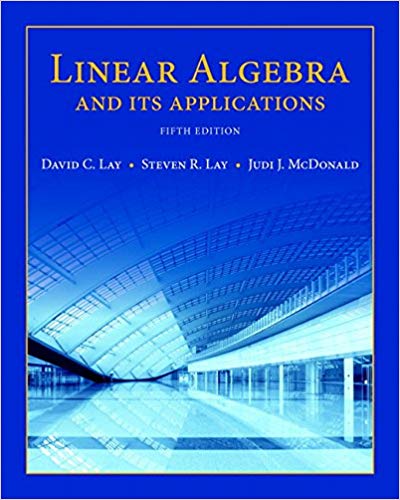
Linear Algebra and Its Applications, 5th Edition
Authors: David C. Lay, Steven R. Lay, Judi J. McDonald
ISBN-13: 978-0321982384
We have solutions for your book!
See our solution for Question 29E from Chapter 4.4 from Lay's Linear Algebra and Its Applications, 5th Edition.
Problem 29E
Chapter:
Problem:
In Exercises 27–30, use coordinate vectors to test the linear independence of the sets of polynomials. Explain your work.
Step-by-Step Solution
Given Information
We are given with following set of polynomial \[ ( 1 - t ) ^ { 2 } , t - 2 t ^ { 2 } + t ^ { 3 } , ( 1 - t ) ^ { 3 } \] We need to find the linear dependence these polynomials using coordinate vectors.
Step-1:
Write the polynomials in standard vector forms: \[\begin{array}{l} {(1 - t)^2} = 1 - 2t + {t^2} = \left[ {\begin{array}{*{20}{c}} 1\\ { - 2}\\ 1\\ 0 \end{array}} \right]\\ t - 2{t^2} + {t^3} = \left[ {\begin{array}{*{20}{c}} 0\\ 1\\ { - 2}\\ 1 \end{array}} \right]\\ {\left( {1 - t} \right)^3} = \left[ {\begin{array}{*{20}{c}} 1\\ { - 3}\\ 3\\ { - 1} \end{array}} \right] \end{array}\]
Step-2: The augmented matrix
\[\begin{array}{l} M = \left[ {\begin{array}{*{20}{c}} 1&0&1&0\\ { - 2}&1&{ - 3}&0\\ 1&{ - 2}&3&0\\ 0&1&{ - 1}&0 \end{array}} \right]\\ = \left[ {\begin{array}{*{20}{c}} 1&0&1&0\\ 0&1&{ - 1}&0\\ 0&{ - 2}&2&0\\ 0&1&{ - 1}&0 \end{array}} \right]:\,\,\left\{ \begin{array}{l} {R_2} = {R_2} + 2{R_1}\\ {R_3} = {R_3} - {R_1} \end{array} \right\}\\ = \left[ {\begin{array}{*{20}{l}} 1&0&1&0\\ 0&1&{ - 1}&0\\ 0&0&0&0\\ 0&0&0&0 \end{array}} \right]:\,\,\left\{ \begin{array}{l} {R_3} = {R_3} + 2{R_2}\\ {R_4} = {R_4} - {R_2} \end{array} \right\} \end{array}\] From the matrix, we can see that there are three variables and two equations. Hence one free variables. Therefore,
The given set is linearly dependent
We are given with following set of polynomial \[ ( 1 - t ) ^ { 2 } , t - 2 t ^ { 2 } + t ^ { 3 } , ( 1 - t ) ^ { 3 } \] We need to find the linear dependence these polynomials using coordinate vectors.
Step-1:
Write the polynomials in standard vector forms: \[\begin{array}{l} {(1 - t)^2} = 1 - 2t + {t^2} = \left[ {\begin{array}{*{20}{c}} 1\\ { - 2}\\ 1\\ 0 \end{array}} \right]\\ t - 2{t^2} + {t^3} = \left[ {\begin{array}{*{20}{c}} 0\\ 1\\ { - 2}\\ 1 \end{array}} \right]\\ {\left( {1 - t} \right)^3} = \left[ {\begin{array}{*{20}{c}} 1\\ { - 3}\\ 3\\ { - 1} \end{array}} \right] \end{array}\]
Step-2: The augmented matrix
\[\begin{array}{l} M = \left[ {\begin{array}{*{20}{c}} 1&0&1&0\\ { - 2}&1&{ - 3}&0\\ 1&{ - 2}&3&0\\ 0&1&{ - 1}&0 \end{array}} \right]\\ = \left[ {\begin{array}{*{20}{c}} 1&0&1&0\\ 0&1&{ - 1}&0\\ 0&{ - 2}&2&0\\ 0&1&{ - 1}&0 \end{array}} \right]:\,\,\left\{ \begin{array}{l} {R_2} = {R_2} + 2{R_1}\\ {R_3} = {R_3} - {R_1} \end{array} \right\}\\ = \left[ {\begin{array}{*{20}{l}} 1&0&1&0\\ 0&1&{ - 1}&0\\ 0&0&0&0\\ 0&0&0&0 \end{array}} \right]:\,\,\left\{ \begin{array}{l} {R_3} = {R_3} + 2{R_2}\\ {R_4} = {R_4} - {R_2} \end{array} \right\} \end{array}\] From the matrix, we can see that there are three variables and two equations. Hence one free variables. Therefore,
The given set is linearly dependent